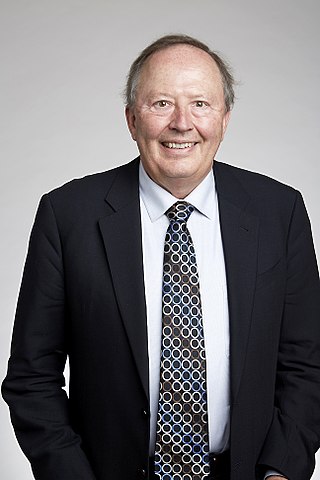
Ecology is the natural science of the relationships among living organisms, including humans, and their physical environment. Ecology considers organisms at the individual, population, community, ecosystem, and biosphere level. Ecology overlaps with the closely related sciences of biogeography, evolutionary biology, genetics, ethology, and natural history.

An ecosystem is a system that environments and their organisms form through their interaction. The biotic and abiotic components are linked together through nutrient cycles and energy flows.

George David Tilman, ForMemRS, is an American ecologist. He is Regents Professor and McKnight Presidential Chair in Ecology at the University of Minnesota, as well as an instructor in Conservation Biology; Ecology, Evolution, and Behavior; and Microbial Ecology. He is director of the Cedar Creek Ecosystem Science Reserve long-term ecological research station. Tilman is also a professor at University of California, Santa Barbara's Bren School of Environmental Science & Management.

Human impact on the nitrogen cycle is diverse. Agricultural and industrial nitrogen (N) inputs to the environment currently exceed inputs from natural N fixation. As a consequence of anthropogenic inputs, the global nitrogen cycle (Fig. 1) has been significantly altered over the past century. Global atmospheric nitrous oxide (N2O) mole fractions have increased from a pre-industrial value of ~270 nmol/mol to ~319 nmol/mol in 2005. Human activities account for over one-third of N2O emissions, most of which are due to the agricultural sector. This article is intended to give a brief review of the history of anthropogenic N inputs, and reported impacts of nitrogen inputs on selected terrestrial and aquatic ecosystems.
Margaret A. Palmer is a Distinguished University Professor in the Department of Entomology at the University of Maryland and director of the National Socio-Environmental Synthesis Center (SESYNC). Palmer works on the restoration of streams and rivers, and is co-author of the book Foundations of Restoration Ecology. Palmer has been an invited speaker in numerous and diverse settings including regional and international forums, science-diplomacy venues, and popular outlets such as The Colbert Report.

Diana Harrison Wall was an American environmental scientist and soil ecologist. She was the founding director of the School of Global Environmental Sustainability, a distinguished biology professor, and senior research scientist at the Natural Resource Ecology Laboratory at Colorado State University. Wall investigated ecosystem processes, soil biodiversity and ecosystem services. Her research focused on the Antarctic McMurdo Dry Valleys and its Wall Valley was named after her. Wall was a globally recognized leader and speaker on life in Antarctica and climate change.

Sharon J. Hall is an ecosystem ecologist and associate professor at the School of Life Sciences at Arizona State University. Her research focuses on ecosystem ecology and the ways that human activity interacts with the environment.
Nancy B. Grimm is an American ecosystem ecologist and professor at Arizona State University. Grimm's substantial contributions to the understanding of urban and arid ecosystem biogeochemistry are recognized in her numerous awards. Grimm is an elected Fellow of the American Geophysical Union, Ecological Society of America, and the American Association for the Advancement of Science.
Pamela H. Templer is an ecosystem ecologist and professor at Boston University who focuses on plant-microbial interaction and their effect on carbon exchange and nutrient cycling. She is also interested in examining how urban ecosystems function, how human actions influence nutrient cycling, atmosphere-biosphere interactions, and other ecosystem processes.
Jana Compton is a research ecologist for the United States Environmental Protection Agency's (EPA) office of research and development. Her work focuses on identifying sources of nitrogen pollution and connecting those issues to how they effect our ecosystem services.
M. Francesca Cotrufo is a soil ecologist who focuses her work on litter decomposition and the dynamics of soil organic matter. She is currently a Professor and Associate Head in the Department of Soil and Crop Sciences, as well the Senior Scientist at the Natural Resource Ecology Lab, at Colorado State University.
Christine Goodale is an ecosystem ecologist and an Associate Professor in the Department of Ecology and Evolutionary Biology at Cornell University. Goodale conducts research that studies the cycling of water, carbon, nitrogen and other nutrients through forest ecosystems.
Anne E. Giblin is a marine biologist who researches the cycling of elements nitrogen, sulfur, iron and phosphorus. She is a Senior Scientist and Acting Director of the Ecosystem Center at the Marine Biological Lab.

Ann M. Bartuska is an ecologist and biologist. She is a senior advisor at Resources for the Future and a former Deputy Under Secretary for Research, Education, and Economics (REE) at the United States Department of Agriculture and former USDA Chief Scientist.
Ingrid C. "Indy" Burke is the Carl W. Knobloch, Jr. Dean at the Yale School of Forestry & Environmental Studies. She is the first female dean in the school's 116 year history. Her area of research is ecosystem ecology with a primary focus on carbon cycling and nitrogen cycling in semi-arid rangeland ecosystems. She teaches on subjects relating to ecosystem ecology, and biogeochemistry.
Kathleen C. Weathers is an ecosystem scientist and the G. Evelyn Hutchinson Chair in Ecology at the Cary Institute of Ecosystem Studies. Her expertise focuses on understanding the ecology of air-land-water interactions. Weathers is the current elected President of the Ecological Society of America (2020-2021).

Jayne Belnap is an American soil ecologist. Her expertise lies in desert ecologies and grassland ecosystems.
Michelle Cailin Mack is an ecologist working on the connections between plants and climate in polar regions. She is a fellow of the Ecological Society of America and the American Geophysical Union. She currently holds the title of Regent's Professor at Northern Arizona University.
Serita D. Frey is an American academic and ecologist, who serves as Professor of Environmental Science at the University of New Hampshire. Her research considers how human activities impact terrestrial ecosystems.
Bridget Emmett is a British ecologist, Professor and Science Area Head for the UK Centre for Ecology & Hydrology. She is the President of British Ecological Society from 2024.








